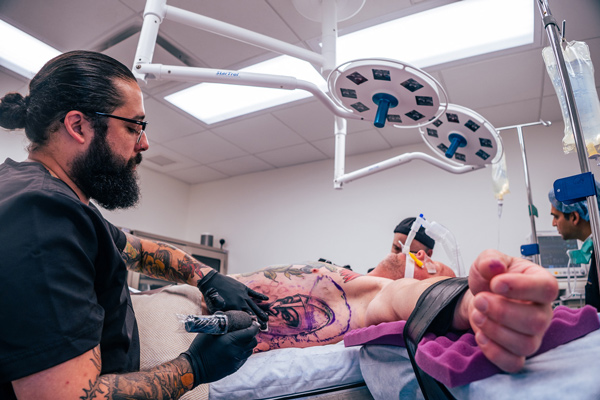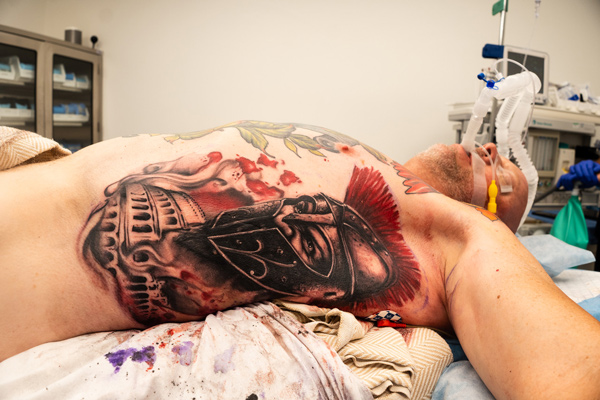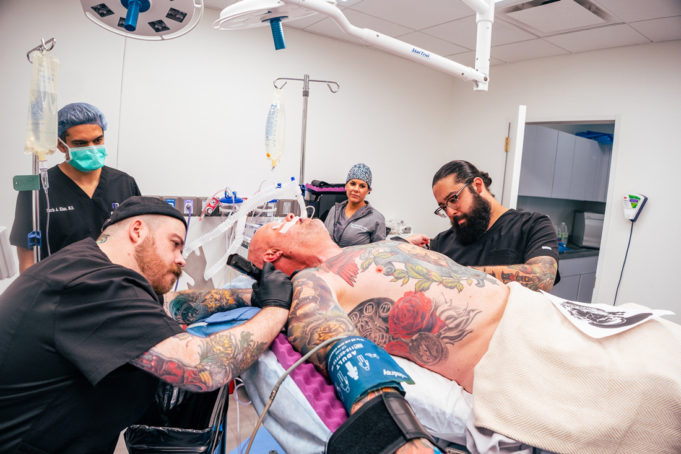I started getting my first tattoo at the ripe old age of 28. I say “started” because it’s a full back piece, and here, 18 years later, it remains unfinished. What was intended to be pirate ship rendered in full color has remained mostly black and gray. There are multiple reasons why it’s incomplete – among them, I had a falling out with the artist over his cantankerous eccentricities – but above all, I just got tired of booking additional sessions to wrap up what turned out to be a bigger ordeal than either of us imagined. At one point, I asked if I could book two sessions in one day, to try to speed things along. The tattooer simply replied that he didn’t think I could handle the pain for that long.
At the time, I thought that was a presumptuous thing to say, but over the ensuing years and eight more tattoos, I have had to concede that he was probably right. It is a lot for most people to get tattooed for a couple hours, let alone six. My experience is that if a tattoo takes an hour or more, it is the last quarter of that duration that hurts the most. No doubt, part of this is psychological, and in response, I’ve dreamed up various scenarios in which I am able to endure the dig of the needle for the three to six hours it would probably take to bring my unfinished tattoo saga to a conclusion. In one of these, I’m maxed out on edibles. In another, I’ve learned to meditate through the pain. Perhaps I could handle six hours of tattooing if I had a massage before and after. I even imagined six hours of suffering in silence just to spite him. But never in all my flights of large tattoo fantasy did it occur to me that such an ordeal might be feasible with the application of general anesthetic.
Getting a big area of your body tattooed is already expensive, but getting inked while conked out in a doctor’s office is the sort of luxury expenditure that is so far beyond my reach that I can’t be bothered to countenance it. But if you possess the financial means of, say, an NFL quarterback or a Grammy-nominated rapper, getting tattooed this way is not only possible but probably soon to be en vogue. At least, that’s what Fort Worth tattooer Scott Prather hopes.
Prather, along with fellow tattooer and business partner Eddy Herrera and a cadre of doctors in Dallas, has launched a new business. Dream Ink Services offers clients large, normally multi-session tattoos (or multiple tattoos done in multiple sessions) in the span of three to six hours while the recipient is blissfully unconscious thanks to the magic of anesthesia. While the practice has been around for a couple years, Prather and Herrera are the first to do it in Texas.
“I guess we’re pioneers, in that regard,” he joked.
Prather has been tattooing for a decade, and five of those years were spent working in shops, mostly at Sleepy Hollow Tattoos when it was in Burleson and after it moved to its current spot in the West 7th corridor. As it happens, I have two pieces from him — done at both locations — and when you spend an hour or two with a person who’s zapping your skin with steel and ink, you get a little bit of a feel for them. My read on Prather is someone who is ambitious to the point of restlessness, driven to chart his own course and forever pushing himself to improve his skills. His tattoo portfolio runs the gamut from neo-traditional to portraiture and just about every other style in between. By his own admission, there are plenty of better artists than him, but after 10 years of tattooing, you know if you’re good at it or not. And Prather knows he’s good.
But also after 10 years, Prather knows he’s at a point in his career where he has to either make a bigger move in the industry — for most tattooers with this mindset, that means opening their own shop — or try something else. But after five years of an appointments-only business model run out of his studio in the Foundry District salon building, Prather didn’t really want to open a shop.
“I don’t think it’s really viable anymore, man,” he told me.
We were in his studio, and he was in the midst of adding reddish brown pigment to a ferret (inspired by fantasy author Brian Jacques’ Redwall novels) in a client’s leg sleeve.
“I mean,” he said, “there are five shops within spitting distance of this room, and working in shops for five years, I learned it’s not really the environment I want to be in.”
For one thing, he has been sober for nearly four years, and he believes that being in a tattoo shop is not conducive to that lifestyle choice. And then there are the finances inherent to running a shop. “When your income is dependent on the people who work for you, you hire people who are busy. You don’t hire people who are good, necessarily. And you can also hire someone who’s a good artist but a shit person, y’know? I think you’re gonna see more artists coming to this type of environment over the next 10 years.”
Prather explored the “do something else” career path, and through his own hustle, he broke into the indie comic book scene. “I made a portfolio and started going to comic cons and meeting people. … I’ve cold emailed people, and I’ve gotten some opportunities through that. I’ve just kind of gotten out there on my own.”
He’s been working on a comic called Higraeth with local writer and artist Andrew Calvert that is about to launch a Kickstarter campaign. “Its title is a Welsh word that’s like a sense of nostalgia for a place you’ve never been.”
Prather has also done covers for a lot of indie comics, to the aim of getting his name out there. “When the time comes [for the Kickstarter], we’ll have a little bit more of a substantial following and promotion from the people I’ve worked with hopefully.”
For all his inroads into the realm of comics, however, Prather was still a tattooer in search of something else to do with his skill set. That’s when Post Malone posted a TikTok of himself getting a bunch of tattoos in what appeared to be a hospital bed. It turned out that the Grammy-nominated rapper and Grapevine native got six pieces done while under general anesthesia in Los Angeles.
Prather said that is when that idea “kind of entered the mainstream.”

Photo by Kole Taylor
*****
I forget exactly what I paid for my back piece, but that year (2006, I think), I’d gotten a Christmas bonus from the company I worked for at the time that was over a grand, and I used all of it on that tattoo. But if I’d spent double or triple on it, I still would have had to grimace and bear it fully conscious. For a person of my means, an anesthesia tattoo is prohibitively expensive.
“The people who do it in L.A., the main tattooers who do this, their price point is like $100,000 minimum,” Prather said, explaining that the fee includes the artists’ time and supplies as well as that of the doctor, his staff and facility, and the procedure itself. “It’ll be like six artists, and they’ll do, like, a whole back piece in six hours. And the clients will be musicians, rappers, professional athletes. They’re people who can afford the cost but can’t afford the time.”
Per his own research, Prather said Los Angeles is pretty much the only place people are getting tattooed this way. “You’ll see things pop up every once in a while, where someone at a dentist office is doing it, like someone’s getting their teeth done and also getting tattooed, but I think that’s kind of a one-off thing.”
I asked Prather if he had an “a-ha, I can totally do this” moment.
“It was when I got contacted by a group of anesthesiologists,” he said
Post Malone’s video predictably went viral, which was how it got the attention of a Dallas-based anesthesiologist named Dr. Harris Khan. Prather said Khan saw a lot potential revenue in such procedures. “For him, it’s like an additional source of income. If he can work not only with surgeons but with someone else who would require anesthesia, then that’s a win for him.”
As to why Khan and his associates contacted Prather, Prather said it was basically happenstance. “Dr. Khan just googled ‘best tattoo shop DFW,’ and he saw [my name], so it was complete luck, essentially, because there are thousands of tattooers in DFW now, y’know? And I’ll be the first to say that there are always gonna be people who are better than me. That’s totally true. But I’m good for my price point, for the style I do … but he asked me to go to dinner with him and some other anesthesiologists and a plastic surgeon named Dr. Robert Schwartz.”
To the dinner at Mercury Chophouse in Arlington, Prather brought along Herrera “because there’s no sense in me doing this by myself. You have to have at least one more person, and we will be subcontracting other artists in the future for large projects.”
Schwartz was important, Prather said, “because we basically had to find a surgeon who would allow tattooers into his surgery suite. Super rare. You’re not going to find a lot of doctors willing to do that. … Tattooers aren’t always known for being the best people — more reasons why I don’t want to be around them — and I can kind of separate myself from the negative connotations of tattooing. I can just be a dude who happens to do tattoos.”
With Khan administering the anesthetic in Schwartz’s facility, Prather and Herrera did their first (and thus far only) general anesthesia tattoos on one of Prather’s longtime clients in May. Like any foray into new territory, the two tattooers ran into a significant learning curve.
“We had to learn that the six hours isn’t actually six hours, because anesthesia time starts before we get in there,” Prather recalled. “They have to set the client up, so it’s really five hours of tattoo time, including the bandaging part. [My client] is just a regular working guy, so he doesn’t have any crazy money. We told him that all he had to pay for was the medical part, so [Herrera] and I did the tattoo pro bono. We did five hours total time, three tattoos, both of his shoulders and his whole left rib panel.”
Last November, the client hated “every single moment” of the chest piece Prather gave him. The client “said it was worth paying double to not feel getting that amount of tattoo work done. I think it was weirdest for us because we’d never been around someone waking up from anesthesia. He was a like a big, bald baby waking up, but he loves his tattoos, and that’s what matters. He didn’t have any residual pain from the procedure, so that was super-encouraging.”

Photo by Kole Taylor
*****
Prather and Herrera are aware of the difference between L.A. prices and DFW prices and have set their fees accordingly. While still out of the reach of most people, their rates are more affordable than the people who tattooed Post Malone.
Prather’s prices are broken down into different cuts. If Prather and Herrera are working together, it’s $4,000 an hour for six hours minimum.
“We can do quite a bit in six hours, just the two of us,” Prather said, “and if we have to bring in other artists, the price per hour goes up. We’re both working for six hours, which makes it a 12-hour tattoo.”
Prather also knows it might take a while for $24,000 tattoos to catch on, but he is confident they will — despite the salt tossed at the procedure by more tradition-minded artists.
“Tattoos aren’t for everyone, and that’s totally fine. Just like this procedure isn’t for everyone. Also, totally fine. But there’s a lot of controversy surrounding tattoos under anesthesia, from a lot of the old hats — that ‘you have to earn it’ type of deal, like having the pain is part of the experience. But it’s one of those things that’s, like, who cares? If you can do it [pain-free], then why not?
“It’s like the artists who say you can only be tattooed by coil machines, not the fancy ‘light sabers’ that we have now,” Prather continued. “It’s part of the evolution of the industry that’s happened over the past 10 years. I think some of that [criticism] stems from a bit of jealousy, that those [previous generations of tattooers] didn’t have this kind of opportunity, but I don’t care what those guys think. If I do six of these over the next year, I’m out of debt. If I do 16 of these in the next three years, my house is paid off. So, who wouldn’t want the opportunity to do this? But then, it’s finding those clients. That’s why it’s important for us to start getting this out there. I mean, I’ve had one client, who could pay half-price. No one else that I know would pay that.”
Of course, finding clients for these kinds of tattoo sessions is Prather’s biggest challenge. He said it would be helpful if he knew someone like a physical therapist who worked with pro athletes who could recommend his services (“I’d be happy to throw them a headhunters fee”), but he is well-aware of the amount of wealth in DFW and is confident those clients will come knocking. But even if his calendar fills up with anesthesia tattoo appointments, he will still continue installing subdermal art the old-fashioned way.
“I’ll always do it. Unless I’m doing, like, three anesthesia tattoos a month, I’ll always be doing this.”












